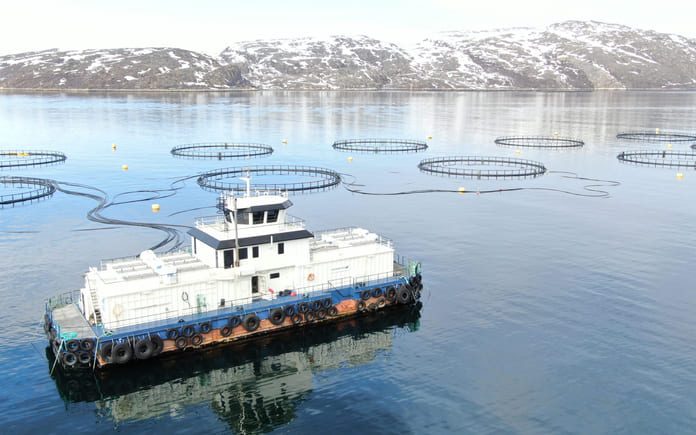The Russian government harbours plans to nearly double domestic salmon production in the next eight years, and is encouraging businesses to open farms in new regions.
According to estimates from the Russian Federal Agency for Fisheries, Rosrybolovstvo, in 2020, the country’s farmers produced 116,000 tonnes of Atlantic salmon and trout, up 27.5 per cent compared to the previous year. Atlantic salmon and trout accounted for 30 per cent of the total Russian aquaculture production last year, compared to only 5 per cent in 2014.
“Russia targets self-sufficiency on salmon,” Ilya Shestakov, Director of Rosrybolovstvo, announced in a statement posted in a government publication. “By 2027 to 2030, Russian Atlantic salmon and trout production is set to climb to 150,000 tonnes per year, plus an additional 70,000 tonnes per year will be grown in the Far East”, Shestakov said.
Russian fishermen catch around 500,000 tonnes of Pacific salmon per year in the Far East but have to export these production quantities to China, South Korea, and Japan due to logistics issues. To sell Pacific salmon in European Russia, the most densely populated part of the country, fishermen have to transport salmon westwards in railway cars for over 9,000 km.

Consumption swings
“Before the 2014 food embargo, the country consumed 200,000 tonnes of salmon per year, of which only 15,000 was covered by local farms”, estimated Anastasia Vladimirova, a consultant with the Moscow-based construction company, Valter Construction. The company is engaged in various aquaculture projects across Russia.
However, in the first years after the embargo, due to import restrictions and the Russian population’s falling purchasing power, the salmon consumption in the country shrank to only 59,000 tonnes per year, she estimated, adding that, in case of growth in domestic production, the consumption is likely to rebound, and reach the pre-embargo level.
Under the country’s Aquaculture Development Program, the Russian North-Western Federal District is expected to produce 120,000 tonnes of salmon per year by 2030.
According to estimates from the State Statistical Service, Rosstat, currently, the Russian North-West produces 70 per cent of the country’s farmed Atlantic salmon and trout. Production occurs primarily at several dozen farms in Murmansk Oblast and the Karelia Republic.

Lack of industrial farms
The largest salmon producer in the country, Russian Aquaculture, runs 49 salmon farming sites in the Barents Sea. In 2020, the company produced 15,500 tonnes of Atlantic salmon, 5 per cent lower compared to the previous year due to cold spring and summer.
This figure is set to rise to 25,000 tonnes per year in 2025. Currently, the company has 28,200 tonnes of Atlantic salmon at its farms, 74 per cent more than the previous year, the company estimated.
Another large scale producer, Russian Salmon, has a production capacity of uptown 30,000 tonnes of salmon in Murmansk Oblast, although the company doesn’t disclose the actual production figure. Russian Salmon is the second largest salmon producer in the country, the Fish Farmer’s Union, Rosrybkhoz said.

The rest of production is unevenly spread between European Russia, the North-West and Siberia, at small farms with the capacity limited to 1,000 tonnes per year. Most of these farms are privately owned, and quite a few are characterized by relatively poor production efficiency.
During the past few years, government officials repeatedly claimed that Russian aquaculture, including the salmon segment, needed more industrial farms to achieve sustainable growth.
Farmed salmon to emerge in the Far East
The Russian North-West is the only part of the country fit for open-water salmon farms Russian Aquaculture indicated, referring to harsh weather conditions in the Far East of the country. This commonly held view has prevailed in Russian aquaculture in recent years.
“In the Far East, natural conditions are unfavourable for breeding salmon due to the absence of bays sheltered from waves and wind,” explained Alexander Fomin, executive director of the Russian Association of Fish Market Producers and Trading Companies. “There are not so many closed bays in the Far East, and the water temperature in the region is not very suitable for growing salmon: in winter, it is too cold, which increases the production cost, decreasing the efficiency,” Fomin added.
In 2020, Russian Aquaculture purchased a part of the Vityaz bay, 30 km south of North Korea, rolling out plans to use it to launch the region’s first salmon farm. According to Fomin, the opportunity is there for Russian Aquaculture to become a trailblazer in the Far East, proving wrong the opinion that the regional climate conditions don’t work for salmon farms.
New farms are promised
Over the past few years, several companies have announced plans to build industrial salmon farms in the country. In 2019, the governor of Tambov region, Sergey Ivanov, said that the Russian company Rybny Vostok would invest 1 billion rubles ($16 million) in a salmon farm with an initial capacity of 1,000 tonnes per year, adding that thanks to further expansion, “eventually this farm would become the largest in Russia.”
Another Russian company Agrocapital promised to build a salmon farm in the Lipetsk Oblast in European Russia for 6 billion rubles ($80 million).
Some foreign companies have also looked at plans to launch projects in Russia. For example, the Norwegian company Naras Watertech announced plans to build a salmon farm with the capacity of 3,000 tonnes per year in the Tatarstan Republic, while the Finnish All Corporation intended to launch a farm in the Novgorod Oblast. However, market participants are confident that not all projects in the Russian salmon industry are destined to be realised.



